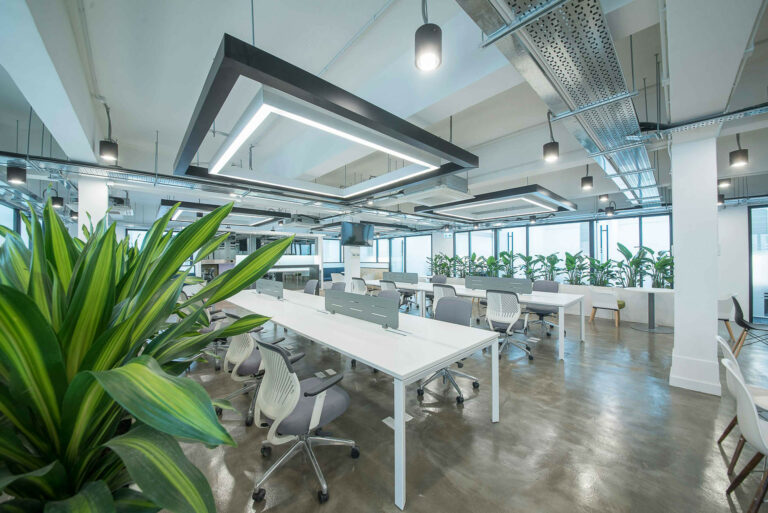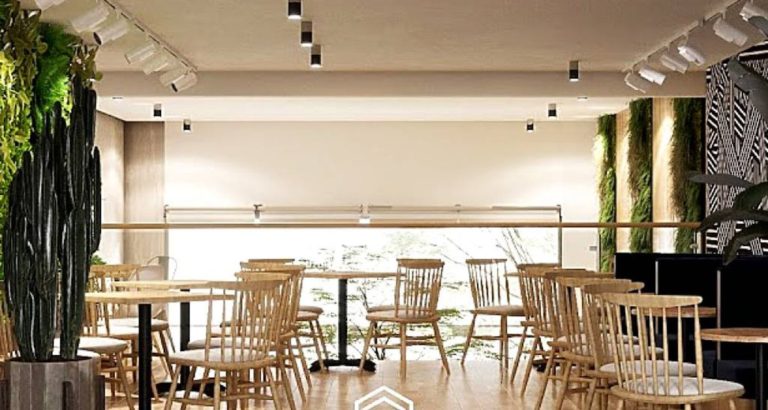Hey there! Welcome to my blog post on the latest trends in coworking spaces. Today, we’re going to dive into the exciting world of sustainability in these shared work environments. So, grab a cup of coffee and let’s explore how coworking spaces are embracing eco-friendly practices and making a positive impact on our planet.

From sustainable office spaces to green initiatives, the environmental impact of coworking spaces is becoming increasingly important. With a focus on sustainable workplace design and eco-friendly coworking practices, these spaces are redefining the way we work and interact.
Imagine working in a space that not only promotes collaboration and networking but also reduces resource consumption. That’s the beauty of sustainable coworking spaces – they prioritize environmental sustainability while providing a productive and inspiring work environment.
Whether it’s through the use of renewable energy, energy-efficient lighting, or incorporating green design elements, coworking spaces are leading the way in creating eco-friendly workspaces. By implementing sustainable business practices and encouraging members to embrace green initiatives, these spaces are setting a new standard for shared workspaces.
So, join me as we explore the different facets of sustainability in coworking spaces, from reducing our carbon footprint to optimizing resource usage. Together, we can champion a sustainable future and make a positive change in the way we work and collaborate. Let’s get started!
Sharing the Office Space and Resources
Coworking spaces are revolutionizing the traditional office environment by promoting sustainability through the sharing of office space and resources. This collaborative approach not only benefits individual professionals but also has a positive impact on the environment and real estate demands.
By sharing office space, professionals can reduce the overall demand for individual offices, resulting in reduced real estate demand and a more efficient use of existing office spaces. This, in turn, helps to conserve land and limit urban sprawl. Moreover, sharing resources such as meeting rooms, printers, and kitchens optimizes energy efficiency, reduces resource consumption, and minimizes the environmental footprint of each individual.
Table:
| Benefits of Sharing Office Space and Resources | Impact |
|---|---|
| Reduced real estate demand | Conservation of land and efficient use of existing spaces |
| Optimized energy efficiency | Lower energy consumption and environmental footprint |
| Resource conservation | Reduction in resource consumption |
“The sharing of office space and resources in coworking spaces not only benefits professionals but also has a positive impact on the environment and real estate demands.”
By adopting a culture of shared office space and resources, coworking spaces have the potential to make a significant contribution to a more sustainable future. The convenience and cost-saving benefits of this collaborative approach attract professionals from various industries, leading to a diverse and vibrant community within coworking spaces.
Engaging in shared office space and resource conservation is not only economically beneficial but also promotes a sense of community, collaboration, and mutual support among professionals. This fosters innovation and creativity while reducing the environmental impact of traditional office setups. Ultimately, by embracing the concept of shared office space and resources, coworking spaces pave the way for a more sustainable and interconnected future.
Accessibility of Coworking Spaces
Coworking spaces offer accessible workspaces that are conveniently located, reducing the need for long commutes to traditional offices. This not only saves time and money for professionals but also helps reduce pollution caused by transportation. By having a private desk at a nearby coworking space, individuals can cut down on transportation costs and contribute to a decrease in their carbon footprint.
Reduced Travel:
- Centralized locations of coworking spaces allow professionals to find a workspace closer to their homes, reducing travel time and costs.
- Access to coworking spaces in urban areas eliminates the need for long-distance commutes to distant offices, resulting in reduced fuel consumption and lower carbon emissions.
Transportation Cost Savings:
- By utilizing coworking spaces nearby, professionals can save on transportation costs, such as fuel, parking fees, and public transportation fares.
- The affordability of coworking spaces makes it a cost-effective alternative to maintaining individual offices, allowing professionals to allocate their resources more efficiently.
Pollution Reduction:
- By reducing the need for daily long commutes, coworking spaces contribute to a decrease in vehicular emissions, thus mitigating air pollution.
- Access to coworking spaces within walking or biking distance promotes sustainable modes of transportation, further reducing pollution and promoting a healthier environment.
The Impact of Accessible Workspaces
“Having a coworking space within minutes of my home has made a significant positive impact on my daily life. Not only do I save time and money on commuting, but I also feel good about reducing my carbon footprint. It’s a win-win situation!” – Jane, Freelancer
With the accessibility of coworking spaces, professionals can work closer to home, enjoying the convenience and cost savings that come with it. This accessibility not only benefits individuals but also contributes to the overall reduction in travel and pollution. By embracing the concept of accessible workspaces, coworking spaces are paving the way for a more sustainable and efficient way of working.
Eco-Friendly Design: Creating Sustainable Coworking Spaces
When it comes to sustainability in coworking spaces, eco-friendly design plays a crucial role. These spaces are intentionally designed to minimize their environmental impact and promote sustainable practices. With a focus on natural light, energy efficiency, and sustainable power and water usage, eco-friendly design principles are integrated into every aspect of a sustainable coworking space.
Natural light is one of the key features of an eco-friendly coworking space. Large windows and skylights are strategically placed to maximize the use of natural daylight, reducing the need for artificial lighting during the day. This not only saves energy but also creates a brighter, more inviting workspace for members. Studies have shown that exposure to natural light can improve mood, productivity, and overall well-being, making it an essential element of sustainable coworking environments.
Energy efficiency is another important aspect of eco-friendly design in coworking spaces. These spaces utilize energy-efficient lighting systems, such as LED lights, which consume significantly less energy than traditional incandescent bulbs. Motion sensor lighting is often installed to ensure that lights are only used when needed, further reducing energy waste. Additionally, sustainable power sources like solar panels may be incorporated to generate clean energy and reduce reliance on fossil fuels.

Sustainable power and water usage are also prioritized in eco-friendly coworking spaces. Energy-efficient appliances and equipment are chosen to minimize electricity consumption. Water-saving fixtures, such as low-flow faucets and toilets, are installed to reduce water usage. Rainwater harvesting systems may be implemented to collect and reuse rainwater for irrigation or other non-potable purposes. These sustainable practices contribute to the overall environmental sustainability of coworking spaces.
Benefits of Eco-Friendly Design in Coworking Spaces
- Reduced energy consumption: By maximizing natural light and utilizing energy-efficient lighting systems, eco-friendly coworking spaces minimize energy consumption, resulting in cost savings and a reduced carbon footprint.
- Improved well-being: Natural light and sustainable design elements create a more pleasant and healthy workspace, promoting the well-being and productivity of the members.
- Resource conservation: Through energy-efficient appliances and water-saving fixtures, eco-friendly design helps conserve valuable resources like electricity and water.
- Sustainability leadership: By embracing eco-friendly design principles, coworking spaces can lead by example and inspire other industries to adopt sustainable practices.
In summary, eco-friendly design is an essential component of sustainable coworking spaces. By incorporating natural light, energy efficiency, and sustainable power and water usage, these spaces create a more pleasant, healthy, and environmentally conscious work environment. With benefits such as reduced energy consumption, improved well-being, and resource conservation, eco-friendly design plays a vital role in shaping the sustainable future of coworking.
Sustainable Interior Design: Enhancing Coworking Spaces with Green Plants and Relaxation Spaces
Coworking spaces not only promote collaboration and innovation but also prioritize the well-being of their members. With a focus on sustainable interior design, these shared workspaces incorporate green plants and relaxation spaces to create a conducive environment for mental and physical well-being.
The presence of green plants in coworking spaces brings numerous benefits. Studies have shown that plants improve air quality, reduce stress levels, and increase productivity. By introducing plants into the workspace, coworking spaces create a fresh and vibrant atmosphere that stimulates creativity and enhances overall well-being.
Additionally, relaxation spaces within coworking spaces provide professionals with areas to unwind and recharge. These spaces can be designed with comfortable seating, soothing lighting, and calming decor. Whether it’s a cozy corner with a bookshelf or a peaceful garden terrace, these relaxation spaces offer a retreat from the busy work environment, allowing individuals to relax and rejuvenate.
Benefits of Sustainable Interior Design in Coworking Spaces:
- Improved air quality: Green plants act as natural air purifiers, reducing toxins and increasing oxygen levels in the workspace.
- Stress reduction: The presence of plants and relaxation spaces promotes relaxation and reduces stress levels among coworkers.
- Increased productivity: Studies have shown that access to nature and relaxation spaces enhances focus and productivity.
- Enhanced well-being: The integration of greenery and relaxation spaces fosters a sense of well-being and satisfaction among professionals.
“The incorporation of sustainable interior design elements, such as green plants and relaxation spaces, creates a harmonious and inspiring environment for coworkers.”
By embracing sustainable interior design practices, coworking spaces demonstrate their commitment to the well-being of their members and the environment. The integration of green plants and relaxation spaces creates a welcoming atmosphere that nurtures creativity, promotes relaxation, and fosters a sense of community among professionals.
| Benefits of Sustainable Interior Design | Green Plants | Relaxation Spaces |
|---|---|---|
| Improved air quality | ✔️ | ❌ |
| Stress reduction | ✔️ | ✔️ |
| Increased productivity | ✔️ | ❌ |
| Enhanced well-being | ✔️ | ✔️ |
Economic Benefit
Sustainable coworking spaces offer numerous economic benefits that make them an attractive option for professionals and businesses. One of the key advantages is cost savings. By opting for a coworking space, individuals and businesses can significantly reduce their overhead expenses. Traditional office setups require hefty investments in rent, utilities, and maintenance, whereas coworking spaces offer flexible membership options and shared resources, allowing for substantial cost savings.
The flexibility of work arrangements is another economic advantage of coworking spaces. With the rise of remote work and freelancing, many professionals value the freedom to choose their own schedule and workspace. Coworking spaces provide this flexibility by offering 24/7 access to their facilities. This allows individuals to work at their own pace and maximize productivity, leading to increased efficiency and potential business growth.
The entrepreneurial spirit is also nurtured in coworking spaces, making them ideal environments for startups and small businesses. These spaces foster collaboration, networking, and knowledge sharing among professionals from diverse backgrounds. By working alongside like-minded individuals, entrepreneurs can gain valuable insights, form partnerships, and access new business opportunities. Additionally, the supportive community within coworking spaces often provides mentorship and resources that contribute to the success of new ventures.
Furthermore, the presence of coworking spaces contributes to local economic development. These spaces attract professionals from various industries and create a vibrant ecosystem that drives innovation and job creation. As more professionals choose coworking spaces, the demand for related services such as cafes, restaurants, and transportation also increases, resulting in a boost for the local economy. Additionally, coworking spaces often invest in sustainability initiatives, which further stimulate economic growth and contribute to a more sustainable future.

The Benefits of Coworking Spaces at a Glance:
- Cost savings through shared resources and lower overhead expenses.
- Flexible work arrangements that allow individuals to choose their own schedule and workspace.
- Entrepreneurship support through collaboration, networking, and access to resources.
- Contribution to local economic development through job creation and increased demand for services.
Sustainability and Coworking: How They Impact
Coworking spaces have a significant impact on sustainability by reducing carbon footprints and optimizing resource utilization. Through the centralization of office spaces and the sharing of resources, coworking spaces contribute to carbon footprint reduction by minimizing the need for individual offices and reducing energy consumption. Shared facilities such as meeting rooms and kitchens promote resource optimization, resulting in a more sustainable use of materials and energy.
In addition to carbon footprint reduction and resource optimization, coworking spaces also promote sustainable practices among their members. Many coworking spaces offer educational programs and workshops on sustainable practices, inspiring individuals and businesses to adopt eco-friendly behaviors. By fostering a culture of sustainability, coworking spaces contribute to positive environmental change and encourage the adoption of sustainable practices in various industries.
Furthermore, the economic benefits of coworking spaces go hand in hand with sustainability. By providing cost-effective alternatives to traditional office spaces, coworking spaces support the growth of small businesses and startups. This not only stimulates economic development but also enables businesses to allocate resources towards sustainability initiatives. The financial savings from shared office spaces can be invested in eco-friendly measures such as energy-efficient technologies and sustainable business practices, resulting in long-term economic and environmental benefits.
| Impact of Coworking on Sustainability | Key Benefits |
|---|---|
| Carbon Footprint Reduction | Minimizes the need for individual offices, reduces energy consumption |
| Resource Optimization | Shared facilities promote efficient use of materials |
| Sustainable Practices | Educational programs inspire eco-friendly behaviors |
| Economic Benefits | Cost-effective alternatives support small businesses and sustainability initiatives |
What is a Sustainable Coworking Space?
When we talk about a sustainable coworking space, we are referring to a shared work environment that prioritizes environmental sustainability, sustainable mobility, and economic sustainability. It goes beyond just the physical design of the space and encompasses a holistic approach to creating a more sustainable future.
In terms of environmental sustainability, a sustainable coworking space focuses on reducing its ecological footprint. This can be achieved through energy-efficient practices such as using renewable energy sources, implementing recycling and waste management programs, and promoting the use of eco-friendly materials. By minimizing resource consumption and maximizing efficiency, these spaces contribute to a greener future.
Another aspect of sustainability in coworking spaces is sustainable mobility. This involves encouraging environmentally friendly transportation options for members, such as biking or using public transportation. Additionally, sustainable coworking spaces may provide amenities like bike racks, showers, and changing rooms to make it easier for individuals to choose sustainable commuting options.
| Sustainable Business Models | Environmental Sustainability | Sustainable Mobility | Economic Sustainability |
|---|---|---|---|
| Collaborative business models that promote sharing of resources among members | Efforts to reduce energy consumption, waste, and carbon emissions | Encouraging sustainable commuting options through incentives and amenities | Providing affordable workspaces that support the growth of small businesses and startups |
| Implementing sustainable practices in day-to-day operations | Promoting recycling and waste reduction | Facilitating the use of public transportation or carpooling | Supporting local economic development through job creation |
| Engaging members in sustainability initiatives | Using eco-friendly materials and practices in construction and renovation | Providing access to bike racks, showers, and changing rooms | Investing in green technologies and initiatives |
“A sustainable coworking space is not just about the physical environment, but also about creating a community that values and actively participates in sustainable practices.”
Economic sustainability is also an essential aspect of a sustainable coworking space. These spaces aim to provide affordable workspaces that support the growth of small businesses and startups. By reducing the financial burden of maintaining individual offices, coworking spaces enable entrepreneurs to invest more in sustainability initiatives and contribute to local economic development.
In conclusion, a sustainable coworking space is a shared work environment that embraces sustainable business models, promotes environmental sustainability, encourages sustainable mobility, and fosters economic sustainability. It is a space where individuals and businesses can work collaboratively towards a greener and more sustainable future.
Conclusion
As I wrap up this article, it’s clear that sustainable coworking spaces are making a positive change in the way we work and collaborate. These shared work environments not only foster innovation and collaboration but also contribute to a more sustainable future.
With a focus on sustainability, coworking spaces are reducing environmental impact and resource consumption. By promoting the sharing of office space and resources, they optimize energy efficiency and minimize waste. This collaborative approach not only benefits the environment but also allows professionals to work in a cost-effective and flexible manner.
By embracing the power of sustainable coworking spaces, we have the opportunity to reshape the way we work and contribute to a healthier planet. These spaces inspire individuals and businesses to adopt eco-friendly practices and create a culture of sustainability. Together, we can create a sustainable future where collaboration and positive change go hand in hand.



